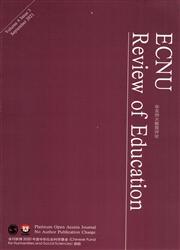Making Sense of Interdisciplinary General Education Curriculum Design: Case Study of Common Core Curriculum at the University of Hong Kong
IF 2.7
Q1 EDUCATION & EDUCATIONAL RESEARCH
引用次数: 1
Abstract
Purpose This research is an interview-based study that captures the academics’ perspectives toward the planning and design of an interdisciplinary General Education Curriculum for undergraduate students in the Chinese context, using the Common Core Curriculum at the University of Hong Kong as a case study. Design/Approach/Methods A total of 28 academics with various levels of academic ranking, disciplinary context, proven teaching excellence, and research productivities were individually invited for and consented to a semi-structured and face-to-face interview. Findings This article suggests four fundamental and interrelated dimensions for consideration when structuring an interdisciplinary General Education Curriculum, namely, how to design, what is worth learning, how to learn and teach, and how to know students have learned. It is suggested that the ideal curriculum should remain coherent and coordinated, broad and balanced, as well as open and flexible, ensuring the capture of knowledge, skills, and attitudes, with the facilitation of active, authentic, and contextualized pedagogies and assessments. Originality/Value This article has the potential of providing insight for policymakers and educators around the world to better structure an interdisciplinary General Education Curriculum by creating an overall springboard for future discussion. They can also integrate these evidence-based elements and strategies into their everyday practices.通识教育跨学科课程设计之意义:以香港大学共同核心课程为例
本研究是一项基于访谈的研究,以香港大学共同核心课程为例,捕捉学者对中国背景下本科跨学科通识教育课程规划和设计的观点。设计/方法/方法共有28位学术排名、学科背景、教学卓越性和研究成果不同的学者被单独邀请并同意进行半结构化的面对面访谈。本文提出了构建跨学科通识教育课程时应考虑的四个基本且相互关联的维度,即如何设计,什么值得学习,如何学习和教授,以及如何知道学生已经学习了。建议理想的课程应保持连贯和协调、广泛和平衡以及开放和灵活,确保掌握知识、技能和态度,并促进积极、真实和具体的教学方法和评价。本文有可能为世界各地的政策制定者和教育工作者提供见解,通过为未来的讨论创造一个全面的跳板,更好地构建跨学科的通识教育课程。他们还可以将这些基于证据的元素和策略整合到他们的日常实践中。
本文章由计算机程序翻译,如有差异,请以英文原文为准。
求助全文
约1分钟内获得全文
求助全文
来源期刊

ECNU Review of Education
Social Sciences-Education
CiteScore
4.90
自引率
0.00%
发文量
41
审稿时长
10 weeks
 求助内容:
求助内容: 应助结果提醒方式:
应助结果提醒方式:


